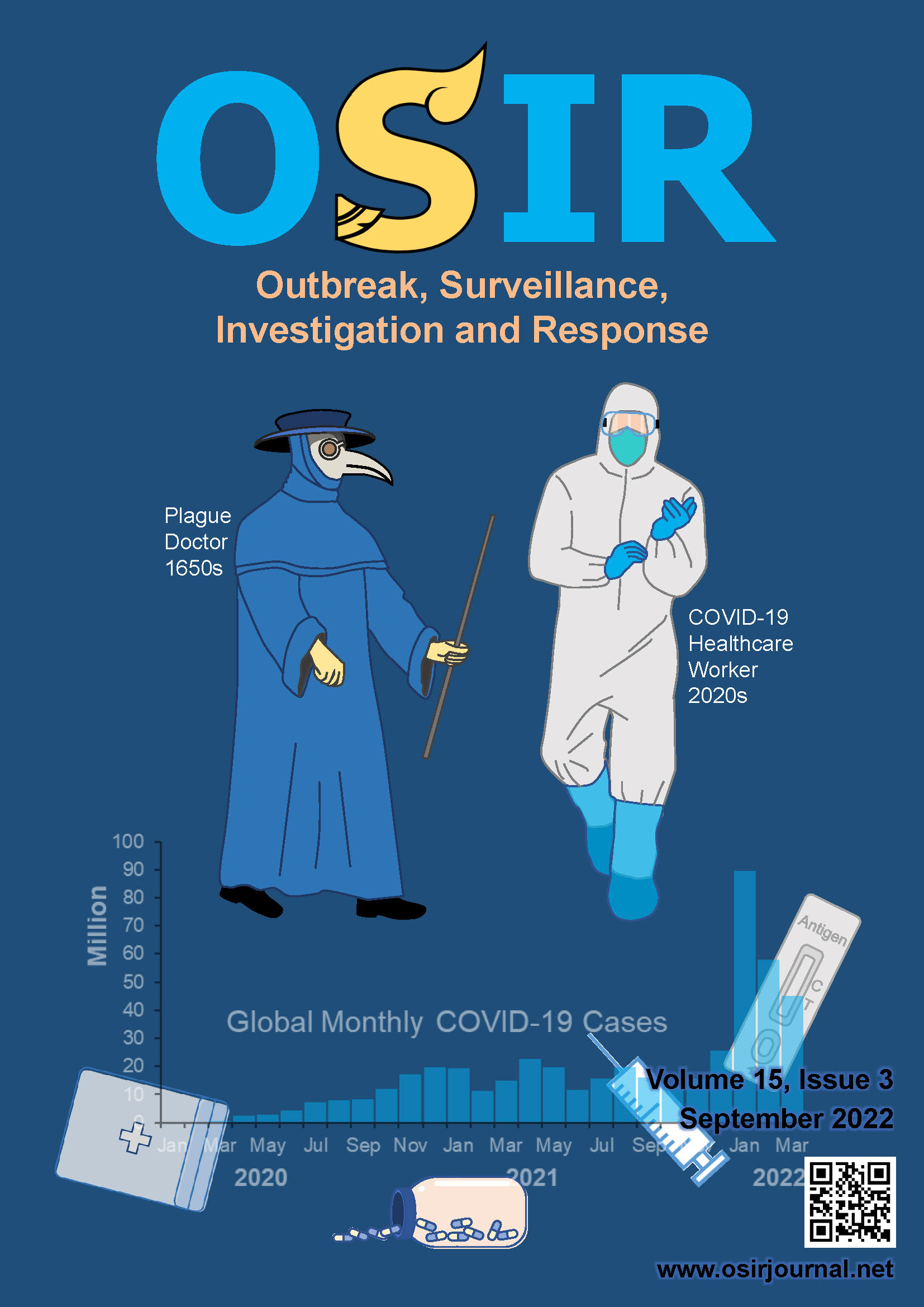Social Determinants and Leprosy in High Endemic Regions of Myanmar: an Ecological Study between 2016 and 2019
DOI:
https://doi.org/10.59096/osir.v15i3.262362Keywords:
leprosy, township, social determinants, MyanmarAbstract
Leprosy has been a public health problem in Myanmar for many centuries. This study aims to explore the situation of leprosy and the association between leprosy and social determinants at the township level in seven endemic regions in Myanmar. The objectives of the study are to (i) describe the incidence and severity of leprosy and the disability due to leprosy in Myanmar between 2016 and 2019, and (ii) determine the correlation between leprosy incidence and social determinants in Myanmar in 2019. We used annual surveillance data of leprosy cases between 2016 and 2019 from the National Leprosy Control Program, Myanmar, and social determinant variables from the 2019 General Administration Department Census Report of Myanmar. An ecological cross-sectional study was conducted. Univariable and multivariable analyses applying zero-inflated negative binomial regression models were used. A geographic information system mapping was used to visualize leprosy cases, disease severity, and disability due to leprosy between 2016 and 2019. The number of all leprosy indicators changing pattern was seen obvious between regions. The eastern region showed relatively an increase in detection of new cases in 2019 compared with years 2017 and 2018. The increase in the detection of multibacillary leprosy cases was also observed in the eastern region during this period. Yet, the detection of Grade-II disability cases across regions remained relatively stable throughout study years. The number of tuberculosis cases per 1,000 population was significantly correlated with leprosy incidence at the township level (risk ratio 1.27, 95% confidence interval 1.04–1.55). These findings highlight the importance of enhancing active case finding campaigns in high-endemic regions, especially the eastern states of Myanmar. Integration of leprosy and tuberculosis case-finding programmes is likely to help leverage resources and maximize efforts to cope with leprosy problems in Myanmar.
References
World Health Organization. Leprosy in SEARO: What is leprosy? [Internet]. Geneva: World Health Organization; [cited 2021 Dec 26]. <https://www.who.int/southeastasia/health-topics/leprosy>
Division of High-Consequence Pathogens and Pathology, National Center for Emerging and Zoonotic Infectious Diseases, Centers for Disease Control and Prevention. Hansen’s Disease (Leprosy) [Internet]. Atlanta: Centers for Disease Control and Prevention; [updated 2017 Feb 10, cited 2021 Dec 26]. <https://www.cdc.gov/leprosy/about/about.html>
Regional Office for South-East Asia, World Health Organization. Global Leprosy Strategy 2016–2020 : Accelerating towards a leprosy-free world [Internet]. New Delhi: WHO Regional Office for South-East Asia; 2016 [cited 2021 Dec 26] <https://apps.who.int/iris/handle/10665/208824>
National Leprosy Control Program, Department of public Health, Ministry of Health and Sports. National Leprosy Control Strategy 2019–2023 [Internet]. Nay Pyi Taw: Myanmar Health Sector Coordinating Committee; 2018 [cited 2021 Dec 26]. 34 p. <https://www.myanmarhscc.org/wp-content/uploads/2019/09/National-Leprosy-Control-Strategy-2019-2023-Myanmar.pdf>
World Health Organization. Global leprosy (Hansen disease) update, 2020: impact of COVID-19 on global leprosy control. Wkly Epidemiol Rec [Internet]. 2021 Sep 10 [cited 2021 Dec 26];96(36):421–44. 24 p. <https://www.who.int/publications-detail-redirect/who-wer9636-421-444>
World Health Organization. Social determinants of health. Geneva: World Health Organization; [cited 2021 Dec 26]. <https://www.who.int/teams/social-determinants-of-health>
Social Determinants of Health, Centers for Disease Control and Prevention. Social Determinants of Health: About Social Determinants of Health (SDOH) [Internet]. Atlanta: Centers for Disease Control and Prevention; [cited 2021 Dec 26]. <https://www.cdc.gov/socialdeterminants/about.html>
Cury MR, Paschoal VD, Nardi SM, Chierotti AP, Rodrigues Junior AL, Chiaravalloti-Neto F. Spatial analysis of leprosy incidence and associated socioeconomic factors. Rev Saude Publica. 2012 Feb;46(1):110–8.
Freitas LR, Duarte EC, Garcia LP. Leprosy in Brazil and its association with characteristics of municipalities: ecological study, 2009–2011. Trop Med Int Health. 2014 Oct;19(10):1216–25.
Kerr-Pontes LR, Montenegro AC, Barreto ML, Werneck GL, Feldmeier H. Inequality and leprosy in Northeast Brazil: an ecological study. Int J Epidemiol. 2004 Apr;33(2):262–9.
Mangum L, Kilpatrick D, Stryjewska B, Sampath R. Tuberculosis and leprosy coinfection: A perspective on diagnosis and treatment. Open Forum Infect Dis. 2018 Jun 5;5(7):ofy133.
Ministry of Health and Sports. Myanmar Demographic and Health Survey 2015-2016. Nay Pyi Taw: Ministry of Health and Sports; 2017 Mar [cited 2021 Dec 26]. <https://dhsprogram.com/pubs/pdf/FR324/FR324.pdf>
World Health Organization. Number of new leprosy cases:2020 [Internet]. Geneva: World Health Organization; [cited 2021 Dec 26]. <https://apps.who.int/neglected_diseases/ntddata/leprosy/leprosy.html>
Nobre ML, Illarramendi X, Dupnik KM, Hacker MA, Nery JA, Jeronimo SM, et al. Multibacillary leprosy by population groups in Brazil: Lessons from an observational study. PLoS Negl Trop Dis. 2017 Feb 13;11(2):e0005364.
Sales AM, Ponce de Leon A, Duppre NC, Hacker MA, Nery JA, Sarno EN, et al. Leprosy among Patient Contacts: A Multilevel Study of Risk Factors. PLoS Negl Trop Dis. 2011 Mar 15;5(3):e1013.
Dharmawan Y, Fuady A, Korfage I, Richardus JH. Individual and community factors determining delayed leprosy case detection: A systematic review. PLoS Negl Trop Dis. 2021 Aug 12;15(8):e0009651. <https://doi.org/10.1371/journal.pntd.0009651>
Li YY, Shakya S, Long H, Shen LF, Kuang YQ. Factors Influencing Leprosy Incidence: A Comprehensive Analysis of Observations in Wenshan of China, Nepal, and Other Global Epidemic Areas. Front Public Health. 2021 May 31;9:666307.
Fischer E, Pahan D, Chowdhury S, Richardus J. The spatial distribution of leprosy cases during 15 years of a leprosy control program in Bangladesh: an observational study. BMC Infect Dis. 2008 Sep 23;8:126.
Donoghue HD. Tuberculosis and leprosy associated with historical human population movements in Europe and beyond–an overview based on mycobacterial ancient DNA. Ann Hum Biol. 2019 Mar;46(2):120–8.
Geluk A, van Meijgaarden KE, Franken KL, Subronto YW, Wieles B, Arend SM, et al. Identification and characterization of the ESAT-6 homologue of Mycobacterium leprae and T-cell cross-reactivity with Mycobacterium tuberculosis. Infect Immun. 2002 May;70(5):2544–8.
Downloads
Published
How to Cite
Issue
Section
License
Copyright (c) 2023 Outbreak, Surveillance, Investigation & Response (OSIR) Journal

This work is licensed under a Creative Commons Attribution-NonCommercial-NoDerivatives 4.0 International License.









